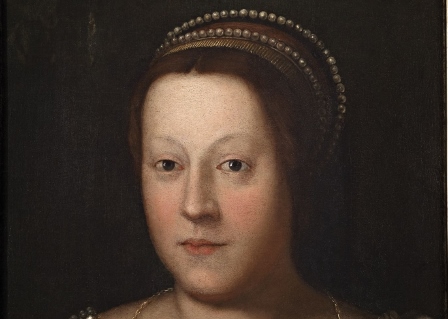
WTI Magazine #72 2015 November 13
Author : Giovanni Verde Translation by: Giulia Carletti
Caterina de' Medici is a famous and controversial protagonist of legends questioning her behalf. She was one of the most powerful and influential women of 16th century Europe. She was born in Florence on the 13rd of April, 1519, daughter of Lorenzo II de' Medici, duke of Urbino, and of Madeleine de la Tour d'Auvergne. He married Enrico II of France and gave birth to Francis II, Charles IX, and Henry III. Her paternal great-grandfather was Lorenzo il Magnifico, while her great-uncle was Pope Leo X.
She received an articulated education and was involved in the alliance between the Pope and Francis I of France, his second child Henry to be married by Caterina. The importance of Caterina's dowry will serve to pay the royal finances' debt. She married Henry in 1533, with a luxurious and majestic celebrations.
When Francis died in March 1547, Henry of Orléans became Henry II and Caterina queen of France. Caterina begun to gradually build up an always more Italian royal administration around her. On the 10th of June, 1549, Caterina was officially named Queen of France in Saint-Denis basilica.
On the 10th of July, 1559, Henry II died for an eye wound occurred during a knightly jousting tournament. Caterina decided to dress in black as sign of mourning. After Henry II, his first fifteen son Francis II came to power. The 1560 death of Francis II, who was affected by a congenital malformation was a heavy blow for Caterina, but it allowed her to come to power, undertaking a policy of tolerance and resolution toward religious conflicts.
Caterina de' Medici was mainly inspired by two movements: the Erasmism, oriented toward a peaceful policy, and the Neoplatonism, predicating the divine mission of the ruler to achieve political harmony. On the 17th of January, 1562, Caterina de' Medici emanates the revolutionary Edict of January, which questioned the sacred bound between politics and religious affairs. Through this edict, Protestants were granted freedom of conscience and religion, provided they returned their places of worship of which they had taken ownership throughout time. According to Caterina de' Medici, the mission of political leaders was to keep people away from the growing violence current looming over the reign.
This event would upset the myth of a woman always seeking for compromises. Caterina worried about the growing importance of the Huguenot party and about the influence that the Admiral of Coligny had on the king. He was an old leader of the Reformation who gathered the grievances of a turbulent nobility. Caterina made a last attempt to reconcile the two parties, by arranging the marriage between her daughter Margaret of Bourbon and Prince Henry III of Navarre, heir of the Bourbon and Navarre possessions. However, challenged by the intransigence of both parties, Caterina agreed on killing the Huguenot leaders come to Paris for the wedding.
The bloodbath, called "The night of San Bartholomew", begins on the night between 24 and 25 August, 1572. This massacre, which uses thousands of victims in Paris and in the provinces, will tremendously weigh over the popularity of Caterina among the Protestant people and generally in history. Yet, very complex analysis doubt about the effective responsibilities of Caterina. Many scholars attribute the authorship of the act entirely to her son.
Caterina de 'Medici dies in Blois, France, on January 5, 1589. Her struggle to bring harmony in the entire Kingdom of France makes her a figure of great importance, which requires respect. The classic iconography of this woman, always portrayed in black, does not give her the credit she deserved for her optimistic and forward-looking action, capable of believing in peace even against all, and of pursuing religious tolerance in the name of a civil cohabitation that will later be the foundation of modern Europe.



